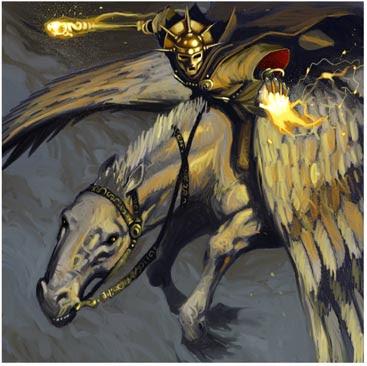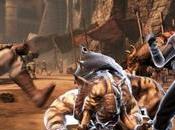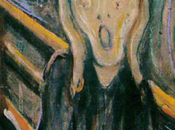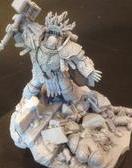
Dopo il suo commento su BOLS, Leibniz si è registrato su Dakka Dakka. Aveva già detto che avrebbe avuto sotto mano il regolamento, infatti, adesso ha postato delle informazioni in merito. Attualmente io credo a questi rumors, ma non c'è ancora una sicurezza al 100%. Hanno comunque ricevuto dei commenti positivi da parte di Hastings, quindi possiamo almeno essere certi che non siano tutte cose inventate.
Fino ad ora pensavo ci fossero anche le basette quadrate, ma a quanto pare c'è un passaggio completo alle tonde, sebbene sembri che ci sia un paragrafo che permetta di usare ancora i modelli già montati su basetta quadrata. Staremo a vedere.
English
SinaLeibniz on Dakka Dakka
No, no, no. No square bases, no rank and file, no two game systems.
I had the chance to look thoroughly through the proper Age of Sigmar rulebook (the one that consists of three books) yesterday evening. Spent my time with the three books and ignored the novel in favour of the real interesting things. So I cannot fill in the blanks there. But maybe I have the opportunity to look at the rulebook and novel again and hopefully the age of sigmar box, too. But now I have a way clearer picture what’s coming and I’d like to share with you because I am very (!!!) excited, but I cannot provide any photos for obvious reasons. So if you don’t believe me, I don’t blame you. But please don’t attack me personally.
- Title of the rulebook is: Age of Sigmar: a Warhammer strategy game
- first the basics (most of which are already known):
- full fledged rule system; no skirmish game - meaning not restricted to low miniature count: 50 models on average, way lower possible, in general you use units but you can field an army consisting of only single models
- everything is on round or oval bases (there paragraph that explicitly allows legacy and diorama bases, though);
- 2 books: the rules (rules and scenarios) and compendium (pictures, unit cards and fluff)
- there are unit cards for every (as far as I can see) old unit in the second book, including warhammer forge models and most or all special characters. Some units get the full treatment with a small fluff text, pictures of the actual miniatures and rules, some units get only rules with nothing more.
- all new rules with complete new mechanics: think not of 40k 2nd -> 3rd but Warhammer 8th -> Bloodbowl, very compact and fast paced, huge emphasis on individual champions, magic and gods (don’t know how powerful, but these have the most rule pages)
- no photos (and no artworks except some very generic drawings) of new miniatures except a couple chaos and human miniatures that are very likely from the Age of Sigmar box.
- all the races are in, but some are clearly favored. There are few pictures of beastmen and lizardmen for example and some units like steamtanks, gunpowder units (Skaven and new-dwarfs use them still), etc. can only be fielded as mercenaries from a different world or summoned units (in case of most special characters, there is even a picture of a Teclis painted in ghost colors)
- the tech level is between and ancient roman empire and early medieval times, lots of nomadic barbarian tribes, etc. But judging by to the age of sigmar miniatures the armour design draws only a little bit from history and is has a very stylized high-fantasy design instead
- there are lots of different people, races, gods and lots of different alliances. The world is a lot more open minded than the old one, Empire-Orc Alliance would be unthinkable, but a human-waaghkin force is nothing unusual in this setting
Army building
- you pick one or more gods that determine the theurgic or magic schools (don’t know what the difference is, sorry) you can use and how your champions get power-ups during the game. You can take several gods, but they have to be from the same pantheon - so no nurgle-sigmar armies, but Nagash-Morr is possible.Then you choose whichever unit you want - from every race. There is no limit as far as I can tell.
- The only mechanic that I have spotted that limits the useful choices somehow is that most spells and special rules only affect units with certain traits, the powers of Grimgor (magic and gods are always connected, each lore has a patron god that grants the power) affects only mortals or enemy units in the proximity of mortals.
- There are only rules for one pantheon in the rule book, all the other gods and pantheons are only mentioned in the fluff
- Guardians of Regalia, a conglomerate native spirits and gods and lately some new gods, the incarnates Grimgor, Gelt and Nagash, there are thousand of gods and their relevance changes over time and in different regions, but there are seven big gods that have seven schools of magic associated with them and have rules in the book
- Geshemet or Gesheket or something like this (male and female, fertility, natural disaster) is the head of the pantheon, the other six gods are dual pair of good and evil:
two death gods: Nagahs and Morr
two smith and labour gods: Hashut and Gelt
two war gods: Grimgor and Myrmidia
- five other pantheon get a page of fluff each, and additional minor pantheons/deities are mentioned in the fluff. The big five are Chaos, Sigmar, Cuth’adai (elven gods), Exoatl (old ones) and the triumvi-rats (Horned Rat + 2 more)
- all characters can earn favor of their gods and get promoted just like the chaos champions until they reach apotheosis, this is also a huge mechanic in the game + you can field gods or at least their avatars, but only three incarnates have rules in the book
Rules
- there is only one ruleset (don’t know what is in the AoS box, but in the book there is no distinction between skirmish mode and battle mode or something like this)
- rules have nothing to do with the old warhammer rules,
- profile is: Melee, Range, Might, Armour, Initiative, Resolve, Wounds, values from 1-6, lower is better
- simple turn sequence: initiative -> player 1 unit 1 moves, shoots, casts -> p1 unit 2 moves, shoots, casts -> ... -> player 2 moves, shoots, casts -> melee
- players roll always against each other, for example Melee vs Initiative and Range vs Initiative, Might vs Armour
- units regenerate all lost wounds at the end of the phase
- both sides in a melee fight simultaneously, winner can roll to fight instantaneously another round until one side is extinct or one side chooses to break from the combat
- there is no moral system or combat resolution whatsoever, but unit can be bounced back
- units use a 1” 40k formation without any facing
- magic spells are all one-use only, when you use it, you have to discard the card
- you can collect ascension points throughout the game and spend the point to buff your champions, mechanic depends on your god(s)
- unit costs points as before, you are not allowed to field multiple units of the same kind unless the former unit have full strength - there are all kinds of unit sizes from 1-3 to 3-15 (that’s the highest I have seen), but you can field lots of different 1-man units
- you don’t buy champions, a set number of models are automatically upgraded to champions, but you cannot exceed the limit
- there are rules for different weapons, magic items, war engines, monsters, special rules, etc and a large section for scenarios and terrain, larger than the actual rules
Setting
game is set on world Regalia that is connected with other young realms through portals of the old ones. Young realms are realms that were populated by the old creators and were guided on similar historical paths. They were untouched by chaos but this has changed since the arrival of sigmar (as a new faith) and archaon (as an actual emissary in flesh and blood)
there is no explanation (or just a brief one so that I have missed it) how this all came to be, just a description of the history of Regalia (and to a lesser extent some neighbouring realms)
On Regalia is dominated by hundreds of human kingdoms. Fast travel is possible through a number of stone circles that allows mages to open portal from one to another and a system of streams and seas under the earth that can be navigated by ship. There were a long period of peace curated by the Exoatl (Old Ones) that watched over the world from the North and Southpole. But then suddenly new faiths arrived, lots of human tribes started to pray to Sigmar and to conquer their neighbouring kingdoms. These lands are each independent, but are united in their faith to Sigmar. The history ends with the conquering of the Worlds Edge mountains and the crowning of the first emperor. At the same time, the first agents of Chaos arrived and began to corrupt the native people. A part of the Waaghkins rebelled against the old ones in favour of new gods, the Skaven arrived the first time, and in the south and east a death cult began to spread. The world is in turmoil. There are lots of unfinished story hooks so I think the story will be continued, but that might be wishful thinking.
humans are the majority in this world and they have kingdom and tribes everywhere, most of the known earth-inspired regions like cathay are there, but they are not described as fully flegded feudal nations but constantly changing petty empires and nomadic people ruled by warlords and champions of the gods. there are two factions of humans, the worshippers of sigmar and the polytheistic rest, both are not monocultural, but have different skin colors and cultures. Women fight beside men!
The dominion of sigmar is special, because they are the only ones that are reluctant to allow any other race than humans. They have only one god and their goal is to destroy all other gods and conquer their domains - for the greater good of the world of course. This has nothing in common with the Empire of the old world, except the heraldry, griffons are still en vogue. All tribes and city states and kingdoms are independent, the only common ground is their faith, the emperor is only a warlord with the purpose to expands the dominion towards the east. There a still knightly orders, zealots, witchhunters - so they retain some of their medieval flair but there are no state troops. There is no gunpowder, except from some dwarven imports, but they are known for using large warwaggons on their trek to the east. Kislec, Estalia, Araby, city states of Bretonnia, Norse and tribes of the Reiklands are part of the dominion. There are also some enclaves scattered across the world that are connected with magic portals
The Skaven arrived on their own on Regalia and are basically the same. Haven’t spent much time on them. They have now three gods called the triumvi-rat …..
Dawikorr (dwarfs) and Inneadim (elfs) have their own realms that are connected with Regalia. The Inneadim have outposts in America.
Dawikorr are only a legend on Regalia and nobody has seen them, but there are legends that they aid whorshippers of Sigmar in peril. They deliver the dominions of Sigmar with artifacts. They live underneath the world Karak Korr and guard the Soul Mill. Dawikorr have rules, so they can be fielded.
The Soul Mill is a huge machinery that allows minor deities to feed on the power of dead spirits or let them reincarnate or serve them as guardian hosts. It was built by the surviving dwarves of the old world on command of the Incarnates on a older machinery of the old ones. The dwarfs guard the soul mill and are aligned with Sigmar after the shattering of the Incarnates, but are under siege of the skaven that have found their way on this world and managed to steal two mighty souls that formed their new gods.
Inneadim whorship the dreamers, gods that have dreamt themselves, basically the elven gods. They live on their own world and protect the dreamchild. Under Araloth they founded enclaves on Regalia in search for the archelves, lost gods of their pantheon. They are a darker take on the elves, nightmare are as much part of their culture then dreams. They use necromancy and the death god Ynnead is at the centre of their pantheon. But they still live in symbiosis with the nature. The artwork shows an elf on a feathered mount, not like a chocobo, but more like a feathered raptor. the artbook shows pictures (and rules) from all existing elf armies.
Skaven and Dawikorr are the only races that use blackpowder, the rest of Regalia is on stuck on an ancient/medieval tech level. The Exoatl use magic techno gear. There is a certain level of anachronistic gear but it is not steampunk but powered by ancient magic. The only steampunk elements are in the Skaven and to a lesser extent the neo-dwarven fluff.
Chaos has no foothold in the north but is anywhere and consists of corrupted tribes and companies from every region of the world. The barbarian theme of the nomadic tribes is more associated with khorne than with chaos as a whole. Beastmen and demons are likely part of their faction because they are described in the same chapter (both in the fluff and unit cards), but demons can be summoned by everyone, so I don’t know for sure. And beastmen have very few pictures, so that’s a bad omen.
Waaghkins: orcs, goblins and are the servants of the old gods and live in a strict caste system, orcs are the manual laborers. There is a new race called nigmos: a tall and slender priest caste. Waaghkins travel the undersea, a system of flooded caverns that connects the whole world, on longboats and do the dirty work for the Exoatl. There is an artwork of the three different kinds of greenskins (no squigs and snotlings mentioned): an ork in very strange armour, very front heavy, textured like a symmetric turtle shell, he wields is an axe with multiple disc shape blades, goblin looked like a viking but has a futuristic looking handgun, the third was taller than a ork, female, slender - probably a nigmo. But in the photos of actual miniatures only show the old orc style. There is a subfaction of waaghkins that changed allegiance from the old gods to grimgor incarnate and are much more ferocious than their cousins.
undeads, deamons and spirits, and guardian hosts are used by every faction of the game, necromancy but not summoning is common in the dominion of Sigmar. The Inneadim are famous for their use of animated constructs. These things are not a big taboo in Regalia. However the most fearsome necromancers are (obviously) employed by the Empire of Nehekhara (which is not a desolate wasteland and has no egyptian vibe but is a rich and green country and feels more babylonian to me) and their death gods. But there is no Undead faction per se anymore. Vampires are called Necrarchs now.
Guardians hosts are troops that were granted by a god from another realm or the realm of the dead. They are living beings and have free will, but were brought to Regalia on the command of a deity.
- Lizardmen are not gone. There is a race called Servants of the Exoatl that guard the pole portals on flying pyramids, but no drawings and no fluff page (other races and tribess get at least half a page). They get unit cards for their old units (which confirms that they are simply lizardmen with a new name), but instead of beautiful pages with pictures like the rest of the bunch they get a simple list in the appendix of the compendium book.
Beastmen get the same lowkey treatment, but ogres get pictures and all, but I cannot say with which pantheon/faction they align. They are mortal, so you can use them in any the guardians of regalia army, but I don’t know if this is a stop gap solution or not.
Age of Sigmar box content:
Extrapolated from the pictures, they are the only new models. If you think you get 3-5 UNITS for each side, you are wrong. you get 10-15 (haven’t counted) CHARACTERS per side. Each model is really individual and it is in no way possible to field the majority of them as a visual coherent unit. It is late and this summary is long as it is, so I make this brief, but I will come back later and add some info on the miniatures. Chaos looks very similar to the old style except the berserkers, the Sigmarite Force is completely different.
Missionary Force:
3 Knights of the Order of Sigmars Blood, Roman looking armour but more bulky, leather Bands, swords and teardrop-shaped shields, champion is a woman
a pair of vigilantes: Male and female, leathercloaked, tricorn, 2 hand-crossbows
a hand full of heavy armoured warrior with different weapons and cloaks, almost knightly in appearance but completely over the top bulky, some have eagleshaped helmets
One hooded, chainmail wearing, hammer wielding girl
a bulldog
standard bearer: naked, chains that are hooked into the flesh, very archaic looking
one arabic looking guy with a two-handed scimitar and full armour
one guy in rags that wields a chain that burns at both ends, very impractical looking
Chaos Cult:
two outriders, basically chaos barbarians as we know them, but female
~5 berserkers: african looking, no armour, barefeet, clad in cloth stripes, two axes, bald and gaunt looking, not overly muscular, bone chain, both male and female
three pristesses: flowing robes, sacrifical ziggzagged daggers, skullmasks
two armoured harpies with spears and shields, crooked looking, feathered wings
at least five chaos warriors similar in appearance to the old chaos warriors, very dynamic fur cloaks and poses, one of them bigger on a larger base, all male as far as I could see
one large bloodletter, almost twice the size of a human
the leader has armour that looks like a chaos dwarfish, very babylonic, rides a demonwolf, a juggernaut, but with flesh and fur and spikes
some more viking-like infantry but with more chainmail
That’s only a broad description. Every model is highly individual.
Sorry for the chaotic nature of the info, I spent the evening writing this in a very fast manner. This is only the tip of the iceberg and I will come back with a little bit more soon - hopefully in a more ordered fashion. If you have a questions or need specifics and a topic, feel free to ask, maybe I remember something of use.
Italiano
SinaLeibniz su Dakka Dakka
No, no, no. Niente basette quadrate, niente ranghi e file e non ci sono due sistemi di gioco.
Ho avuto la possibilità di analizzare il regolamento vero e proprio di Age of Sigmar (quello diviso in tre libri) ieri sera. Ho speso il mio tempo con i tre libri e ho ignorato il romanzo in favore delle cose veramente interessanti, quindi non posso riempire gli spazi vuoti che avevo lasciato, ma forse riuscirò a vedere nuovamente entrambi e magari anche la scatola di Age of Sigmar. Ma adesso ho una visione molto più chiara di cosa sta arrivando e vorrei condividerla con voi perché sono molto (!!!) eccitato, ma non posso fornire foto per ovvie ragioni. Per questo motivo, se non mi credete non vi biasimo, ma non attaccatemi.
- Il titolo del regolamento è: Age of Sigmar: a Warhammer strategy game
- Prima le basi (la cui maggior parte è già conosciuta):
- Un sistema di regole completo a tutti gli effetti: niente schermaglie, ovvero non c'è una limitazione a pochi modelli: 50 modelli medi, ma anche meno. Generalmente usate delle unità, ma potete schierare un esercito composto solo da singoli modelli.
- Tutto è su basette ovali o tonde (però il paragrafo permette esplicitamente basette vecchie e da diorama).
- 2 libri: The Rules (regole e scenari) e Compendium (immagini, carte unità e background).
Ci sono carte unità per ogni (per quanto ho visto) vecchia unità nel secondo libro, inclusi i modelli Warhammer Force e tutti (o quasi) i personaggi speciali. Alcune unità ottengono il trattamento completo con un po' di background, immagini degli attuali modelli e regole, altre ottengono solo le regole e niente di più.
- Regole e meccaniche completamente nuove: non pensate ad un passaggio tipo 40k 2a->3a, ma a 8a->Blood Bowl. Molto compatto e dal ritmo veloce. Grande enfasi sui campioni singoli, magia e divinità (non so quanto siano potenti, ma riempono la maggior parte delle regole).
- Niente foto (e nessun artwork, eccetto alcuni disegni molto generici) di modelli nuovi eccetto un paio di modelli del caos e umani che molto probabilmente arrivano dalla scatola di Age of Sigmar.
- Ci sono tutte le razze, ma alcune sono chiaramente favorite. Ad esempio, ci sono alcune immagini di uominibestia e uomini lucertola. Alcune unità come i carri a vapore e le unità a polvere da sparo (Skaven e nuovi-Nani le usano ancora) possono essere solo usate come mercenari da un mondo differente o come unità evocate (nel caso delle maggior parte dei personaggi speciali, c'è anche un'immagine di Teclis dipinto con colori spettrali).
- Il livello di tecnologia è tra l'antico impero romano e i primi anni del Medioevo, con molte tribù barbariche nomadi, etc. Osservando i modelli di Age of Sigmar, il design delle armature prende solo piccole parti dalla storia, ma è molto high fantasy stilizzato.
- C'è una sacco di varietà tra persone, razze e divinità e un sacco di alleanze diverse. Il mondo è molto più aperto mentalmente rispetto al precedente (e direi finalmente). Un'alleanza Impero-Orchi sarebbe impensabile, ma una umani-waaaghkin non è niente di insolito in questa ambientazione.
Composizione dell'Armata
- Prendi uno o più divinità che determinano le scuole magiche o teurgiche (scusatemi, non so quale sia la differenza) che puoi usare e il modo in cui i tuoi campioni ottengono miglioramenti durante la partita. Puoi prendere diverse divinità, ma devono provenire dallo stesso pantheon - quindi niente eserciti Nurgle-Sigmar, ma è possibile Nagash-Morr. Successivamente scegli le unità che vuoi da ogni razza. Per quanto ne so, non c'è un limite.
- Le uniche meccaniche che ho visto limitare delle cose utili dice che la maggior parte degli incantesimi e regole speciali influenzano unità con determinati tratti. Il potere di Grimgor (magie e divinità sono sempre connessi, ogni sapere ha il proprio dio patrono che garantisce il potere) influenza solo i mortali o le unità nemiche vicine ai mortali.
- Ci sono solo regole per un pantheon all'interno del regolamento, tutte le altre divinità e gli altri pantheon vengono solo menzionati nel background.
- I Guardiani di Regali, un insieme di spiriti e divinità locali e ultimamente alcune nuove divinità, ossia le incarnazioni Grimgor, Gelt Nagash. Ci sono migliaia di divinità e la loro importanza cambia nel tempo e in differenti regioni, ma ci sono sette grandi divinità che hanno altrettante sette scuole della magia associate con regole specifiche.
- Geshemet o Gesheket o qualcos'altro del genere (maschi e femmine, fertilità, disastri naturali) è il capo del pantheon, gli altri sei dei sono coppie divise tra bene e male:
Due divinità della morte: Nagash e Morr.
Due divinità dei fabbri e della manodopera: Hashut e Gelt.
Due divinità della guerra: Grimgor e Myrmidia.
- Cinque altri pantheon hanno una pagina di background ciascuno, inoltre vengono menzionati altri dei e pantheon. I cinque principali sono Caos, Sigmar, Cuth'adai (dei elfici), Exoatl (antichi) e il Triumvi-ratto (Ratto Cornuto e altri due). (Spero che Gotrek divino venga almeno nominato da qualche parte)
-Tutti i personaggi possono guadagnarsi il favore del proprio dio ed essere promossi proprio come i campioni del caos finché non raggiungono l'apoteosi. Tutto ciò rappresenta una grande meccanica nel gioco, inoltre possono anche essere schierati gli dei o almeno i loro avatar, ma solo tre incarnazioni hanno regole nel libro.
Regole
- C'è solo un set di regole (non so cosa ci sia nella scatola di AoS, ma nel libro non c'è distinzione tra schermaglia e battaglia campale o cose simili).
- Le regole non hanno nulla a che fare con quelle vecchie di Warhammer.
- I profili hanno: Mischia, Tiro, Forza, Armatura, Iniziativa, Determinazione, Ferite. I valori vanno da 1 a 6, più è basso e meglio è (praticamente come i tiri salvezza).
- Semplice sequenza del turo: iniziativa -> giocatore 1 unità 1 muove, tira, casta -> giocatore 1 unità 2 muove, tira, casta -> ... -> giocatore 2 muove, tira, casta -> mischia.
- I giocatori tirano sempre l'uno conto l'altro. Ad esempio, Mischia contro Iniziativa, Tiro contro Iniziativa e Forza contro Armatura.
- Le unità rigenerano tutte le ferite perse alla fine della fase.
- Entrambi gli schieramenti in mischia combattono contemporaneamente, il vincitore può tirare per combattere istantaneamente un altro round finché una delle parti non viene completamente eliminata o una non decide di uscire dal combattimento.
- Non c'è un sistema per il morale o per la risoluzione del combattimento, ma le unità possono essere respinte.
- Le unità usano una formazione con 1" di distanza tra i modelli come nel 40k
- Gli incantesimi si possono usare solo una volta. Quando li usi, devi scartare la relativa carta.
- Puoi raccogliere punti ascensione durante la partita e puoi spenderli per dare dei potenziamenti ai tuoi campioni. La meccanica dipende dalla tua/tue divinità.
- I costi in punti delle unità sono come prima, ma non puoi schierare più volte la stessa unità se quella precedente non è al completo. Ci sono tanti tipi di dimensione dell'unità, da 1-3 a 3-15 (questo è il più alto che ho visto), ma è possibile schierare molte unità differenti composte da modelli singoli. I campioni non vengono acquistati, ma generati automaticamente e non è possibile superare un certo limite.
- Ci sono regole per diversi oggetti magici, armi, macchine da guerra, mostri, regole speciali, etc. e una grande sezioni per scenari e terreni, più grande di quella attuale.
Ambientazione
Il gioco è ambientato sul pianeta Regalia, il quale è connesso ad altri regni giovani tramite i portali degli antichi. I regni giovani erano popolati dai vecchi creatori ed erano guidato verso sentieri storici simili. Erano rimasti incontaminati dal Caos, ma ciò è cambiato dall'arrivo di Sigmar (come nuova fede) e di Archaon (come vero e proprio emissario in carne e ossa).
Non viene spiegato come tutto ciò si generi (o forse era piccola e mi è sfuggita), solo una descrizione della storia di Regalia (e, più brevemente, quella di alcuni regni vicini).
Regalia è dominata da centinaia di reami umani. Il viaggio veloce è possibile tramite un certo numero di cerchi di pietre (GW, I see what you did there) che consentono ai maghi di aprire portali da un reame all'altro, ma anche tramite un sistema di correnti e mari sotterranei navigabili. C'è stato un lungo periodo di pace grazie agli Exoatl (antichi) che sorvegliavano il mondo dai poli Nord e Sud, ma improvvisamente arrivarono nuove fedi. Molte tribù umane iniziare a venerare Sigmar e a conquistare i reami vicini. Queste terre sono indipendenti, ma sono unite dalla fede in Sigmar. La storia finisce con la conquista delle montagne dei Confini del Mondo e la coronazione del primo imperatore Allo stesso tempo, i primi agenti del Caos arrivarono e iniziarono a corrompere le popolazioni locali. Una parte dei Waaaghkin si ribellò dal dominio degli antichi in favore di nuove divinità. Gli Skaven arrivarono a sud e ad est, diffondendo un culto della morte. Il mondo è in subbuglio. Ci sono tanti agganci narrativi inconclusi quindi penso che la storia venga continuata, ma forse questo è solo un mio desiderio.
Gli umani sono la maggioranza su questo pianeta e hanno tribù e domini ovunque. La maggiore parte delle regioni ispirate a quelle veramente esistenti sulla Terra sono lì, ad esempio il Cathay. Non vengono descritte come nazioni feudali a tutti gli effetti, ma come piccoli imperi in costante cambiamenti e popolazioni nomadi comandate da signori della guerra e campioni degli dei. Ci sono due fazioni umane, i seguaci di Sigmar e la restante parte politeista. Entrambe sono monoculturali, ma hanno diversi colori della pelle e culture. Le donne combattono al fianco degli uomini!
Il dominio di Sigmar è speciale perché i suoi seguaci sono gli unici riluttanti ad ammettere altre razze fuori dagli umani. Hanno un solo dio e il loro obiettivo è distruggere tutti gli altri dei e conquistare i loro domini - per il bene superiore del mondo, ovviamente. Questo non ha niente a che fare con l'Impero del vecchio pianeta. A parte l'araldica, i grifoni vanno ancora di moda. Tutte le tribù, le città stato e i reami sono indipendenti, ciò che li accomuna è la fede. L'Imperatore è solo un comandante con lo scopo di espandere i propri domini verso est. Ci sono ancora gli ordini cavallereschi, gli zeloti e i cacciatori di streghe, quindi possiedono ancora un po' del loro fascino medievale, ma non ci sono truppe di stato. Non c'è la polvere da sparo, a parte qualche importazione nanica, i quali però sono conosciuti per il loro utilizzo di grandi carri da guerra nel loro percorso verso est Kislev, Estalia, Araby, le città stato di Bretonnia, Norsca e le tribù del Reikland fanno parte di questi domini. Ci sono anche alcuni enclavi sparsi per il mondo e connessi tramite portali magici.
Gli Skaven sono arrivati da soli su Regalia e sono praticamente uguali. Non ho speso molto tempo su di loro. Adesso hanno tre dei chiamati il Triumvi-ratto...
I Dawikorr (nani) e gli Inneadim (elfi) hanno i propri regni connessi con Regalia. Gli Inneadim hanno degli avamposti in America. (quindi dove stavano prima gli elfi oscuri)
I Dawikorr sono solo una leggenda su Regalia e nessuno li ha mai visti, ma ci sono leggende che parlano del loro aiuto nei confronti nei seguaci di Sigmar in pericolo. Donano artefatti ai domini di Sigmar. Vivono sotto la superficie del mondo Karak Korr e sorvegliano la Fabbrica dell'Anima. I Dawikorr hanno delle regole, quindi possono essere schierati.
La Fabbrica dell'Anima è un macchinario enorme che permette a delle divinità minori di nutrirsi del potere degli spiriti dei morti, farli reincarnare o servirli come schiere di guardiani. E' stata costruita dai nani sopravvissuti del vecchio mondo per ordine delle Incarnazioni sulla base di un vecchio macchinario degli Antichi. I nani sorvegliano la Fabbrica dell'Anima e sono alleati con Sigmar da quando c'è stata la frammentazione delle Incarnazioni, ma sono assediati dagli Skaven, i quali hanno trovato una via per questo mondo e sono riusciti a rubare due anime molto potenti che hanno formato i loro due nuovi dei.
Gli Inneadim venerano i sognatori, ossia dei che hanno sognano se stessi, praticamente gli dei elfici. Vivono sul proprio mondo e proteggono il bambino dei sogni. Sotto il comando di Araloth, hanno fondato enclavi su Regalia in cerca degli arcielfi, dei perduti del loro pantheon. Sono una visione più oscura degli elfi, dato che gli incubi fanno parte della loro cultura tanto quanto i sogni. Usano la necromanzia e il dio della morte Ynnead è al centro del loro pantheon. Vivono comunque ancora in simbiosi con la natura. Gli artwork mostrano un elfo su una cavalcatura piumata, non come un chocobo, ma più simile ad un raptor piumato (Magari sta parlando di un nuovo tipo di Naggaronte?). L'artbook mostra immagini (e regole) per tutti gli eserciti elfici esistenti.
Gli Skaven e i Dawikorr sono le uniche razza che usano la polvere da sparo, il resto di Regalia è rimasto ad un livello di tecnologia antico/medievale. Gli Exoatl usano una sorta di tecno-magia. C'è un certo livello di tecnologia anacronistica, ma non è steampunk, viene alimentata dalla magia. Gli unici elementi steampunk sono negli Skaven e in maniera minore rispetto al background dei nuovi-nani.
Il Caoos non domina il nord, ma è ovunque e consiste di tribù corrotte e compagnie provenienti da ogni regione del mondo. Il tema barbarico delle tribù nomadi è più associato a Khorne che al Caos nel suo insieme. Gli Uominibestia e i Demoni fanno molto probabilmente parte della loro fazione perché vengono descritti nello stesso capitolo (sia nel background che nelle carte unità), ma i Demoni possono essere evocati da tutti, quindi non ne sono certo. Gli Uominibestia hanno proprio poche immagini ed è un cattivo segno.
Waaghkins: orchi e goblin, servi dei vecchi dei che vivono con un rigido sistema di caste e fungono da lavoratori manuali. C'è una nuova razza chiamata nigmos: una casta di preti alti ed esili. I Waaaghkins viaggiano nel mare sotterraneo, un sistema di caverne inondate che connettono l'intero pianeta, usando scialuppe e facendo il lavoro sporco degli Exoatl. C'è un artwork che mostra i tre differenti tipo di pelleverde (niente squig e caccole menzionante): un orco con un'armatura molto strana, molto corazzata sul fronte, texturizzata come come guscio di tartaruga simmetrico, armato di un'ascia con numerose lame a forma di disco; il goblin sembrava un vichingo, ma ha una pistola dall'aspetto futuristico; il terzo era più alto di un orco, femmina ed esile - probabilmente un nigmo. Le foto dei modelli, però, mostrano solo gli orchi vecchio stile. C'è una sottofazione di Waaaghkins che ha cambiato devozione, passando dai vecchi dei all'incarnazione Grimgor. Essi sono molto più feroci rispetto ai propri cugini.
Nonmorti, Demoni e spiriti sono le schiere di guardiani usato da ogni fazione nel gioco. La necromanzia, ma non l'evocazione, è una pratica comune nel dominio di Sigmar. Gli Inneadim sono famosi per il loro uso di costrutti animati. Queste cose non sono una grande taboo su Regalia. Comunque i necromanti più temuti vengono impiegati (ovviamente) dall'Impero e da Nehekhara (la quale non è una terra devastata e desolata e non ha un'atmosfera egizia, ma è una nazione ricca e verdeggiante dall'aspetto molto più babilonese secondo me) e i loro dei. Non c'è più una fazione nonmorta a sé stante. Adesso i Vampiri vengono chiamati Necrarchi.
Le schiere di guardiani sono truppe create da un dio di un altro regno oppure riportate indietro dal regno dei morti. Sono esseri viventi e hanno libero arbitrio, ma sono stati portati su Regalia per ordine di una divinità.
- Gli Uomini Lucertola non se ne sono andati. C'è una razza chiamata Servi degli Exoatl che sorveglia i portali ai poli grazie a delle piramidi volanti (probabilmente le ziggurat che hanno preso il volo alla fine di End Times: Thanquol), ma non ci sono artwork o pagine di background (le altre razze e tribù hanno almeno mezza pagina).
Hanno le carte unità per le loro vecchie unità (che confermano una cosa: sono semplicemente Uomini Lucertola con un nuovo nome), ma, al posto di belle pagine con immagini come per gli altri, hanno una semplice lista nelle appendici del Compendium.
Gli Uominibestia hanno ricevuto lo stesso trattamento, mentre gli ogre hanno immagini e tutto il resto, ma non so con che pantheon o fazione siano allineati. Sono mortali, quindi è possibile usarli in ogni eserciti di guardiani di Regalia, ma non so se sia una soluzione per tappar i buchi o qualcos'altro.
Contenuto della scatola di Age of Sigmar:
Estrapolate dalle immagini, questi sono gli unici nuovi modelli. Se pensate di ottenere 3-5 unità per ogni parte, allora vi sbagliate. Ottenete 10-15 (non ho contato) personaggi per parte. Ogni modelli è veramente unico e non è proprio possibile schierare la maggior parte di essi come un'unità visivamente coerente. E' tardi e questo riassunto è lungo, quindi parlerò di questo brevemente, ma ritornerò più tardi e aggiungerò alcune informazioni sui modelli. Il Caos è molto simile al vecchio simile eccetto i berserker, i Sigmariti sono completamente diversi.
Schiera Missionaria:
3 Cavalieri dell'Ordine del Sangue di Sigmar. Armatura dell'aspetto romano, ma più massiccia, fasce di cuoio, spade e scudi a forma di goccia. Il campione è una donna.
Un paio di vigilanti: maschio e femmina, mantelli di cuoio, tricorno, 2 balestre a una mano.
Una manciata di guerrieri completamente corazzati con armi e mantelli differenti, quasi cavallereschi nell'aspetto, ma molto massicci. Alcuni hanno elmi a forma di aquila.
Una donna incappucciata con cotta di maglia e armata di martello.
Un bulldog (non penso intenda il cane)
Stendardiere: ha un aspetto molto arcaico, è nudo e ha delle catene attaccate alla carne.
Un uomo dall'aspetto arabico con una scimitarra a due mani e armatura completa.
Un uomo vestito di stracci che brandisce una catena che arde alle estremità, veramente poco pratica.
Culto del Caos
Due outrider, in sostanza barbari del caos come li conosciamo, ma donne.
~5 berserker: aspetto africano, nessun armatura, piedi piatti, coperti da strisce di stoffa, due asce, pelati e scarni, non troppo muscolosi, catene d'osso, sia uomini che donne.
Tre pretesse: vestiti svolazzanti, daghe sacrificali zigzagate, maschere a forma di teschio.
Due arpie corazzate con lance e scudi, ricurve e con ali piumate.
Almeno cinque guerrieri del caos simili a quelli attuali, ma con pose e mantelli molto dinamici. Uno di essi è più grosso e montato su una basetta più grande. Tutti uomini per quanto ho potuto vedere.
Un grosso Sanguinario, quasi due volte le dimensioni di un umano.
Il leader ha un'armatura che sembra provenire dai nani del caos, stile babilonico, cavalca un lupo demoniaco, praticamente un juggernaut, ma con carne, pelo e spuntoni.
Altra fanteria dall'aspetto vichingo, ma con più cotta di maglia.
Questa è solo una descrizione generale. Ogni modello è molto particolare.
Mi scuso per la natura caotica delle informazioni, ho impiegato tutta la sera scrivendo questa in maniera molto veloce. Questa è solo la punta dell'iceberg e ritornerò presto con altro materiali - si spera in modo più ordinato. Se avete domande o avete bisogno di dettagli, sentitevi liberi di chiedere, magari ricordo qualcosa di utile.






